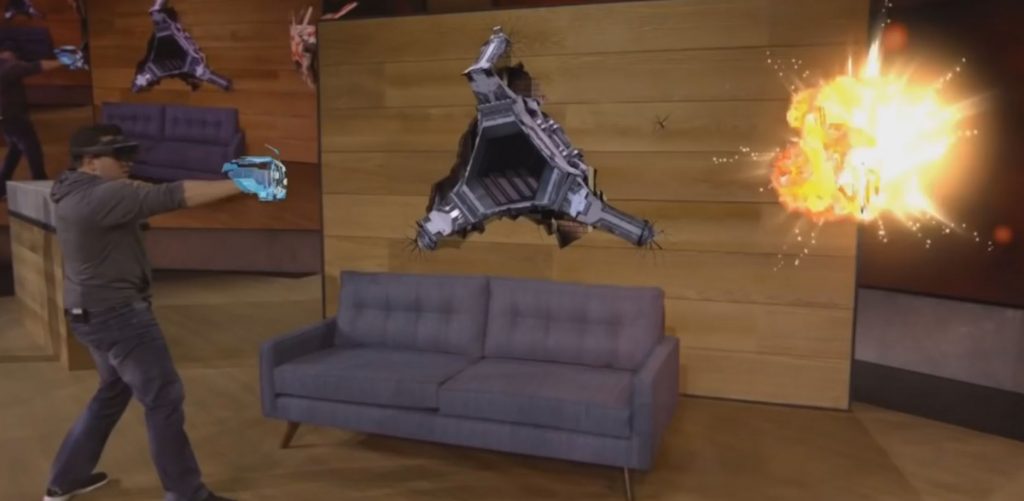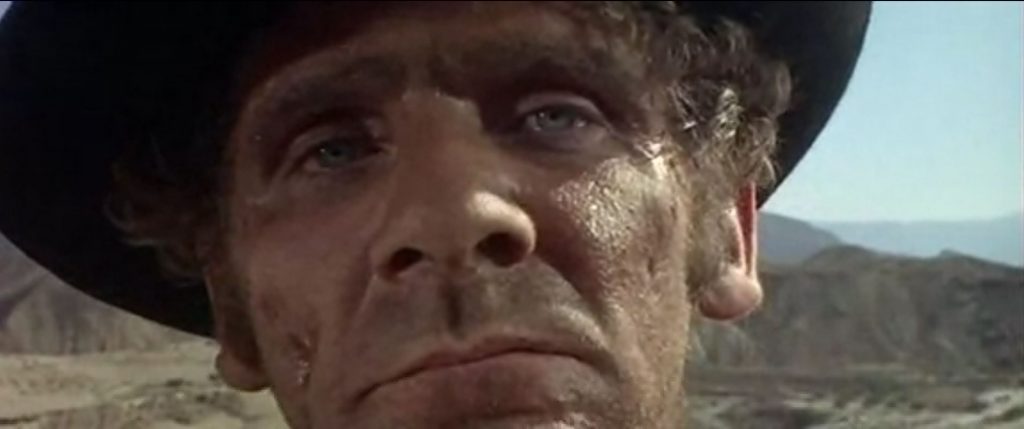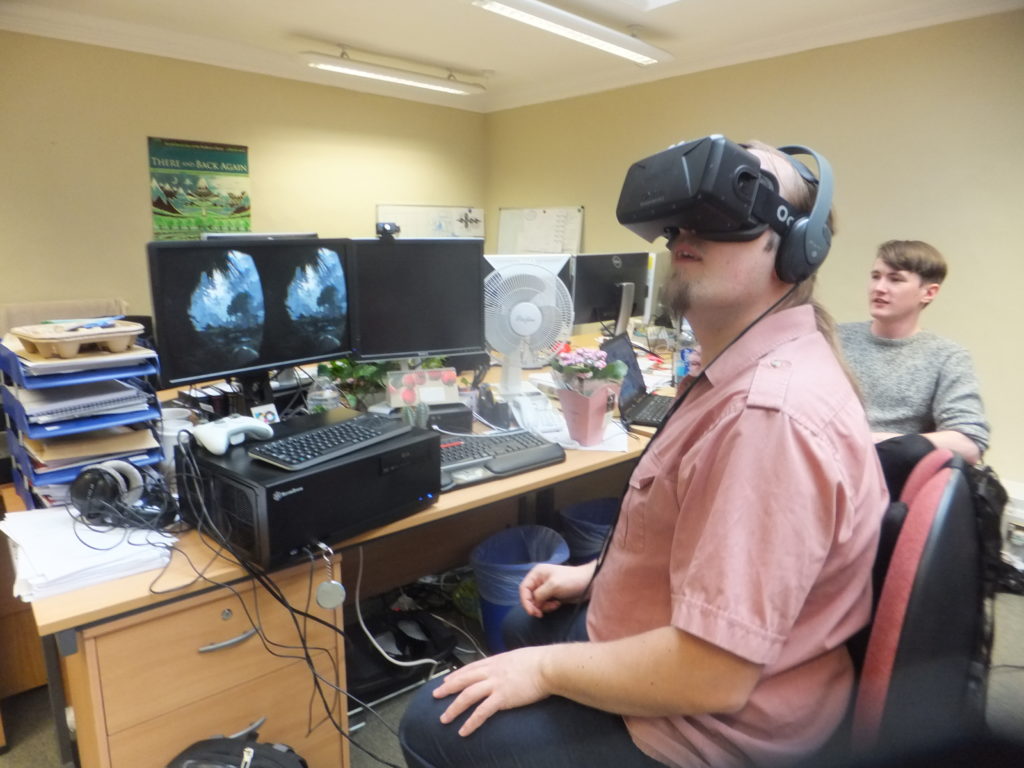This is the second in a three-part blog post about telling stories using virtual reality. Read all of the parts here.
I’m still waiting to get in on the Oculus Rift and HTC Vive magic when they’re made generally-available, later this year. But for the meantime, I’m enjoying quite how hackable VR technologies are. I chucked my Samsung Galaxy S6 edge into an I Am Cardboard DSCVR, paired it with a gaming PC using TrinusVR, used GlovePIE to hook up a Wii remote (playing games with a keyboard or even a gamepad is challenging if your headset doesn’t have a headstrap, so a one-handed control is needed), and played a game of Gone Home. It’s a cheap and simple way to jump into VR gaming, especially if – like me – you already own the electronic components: the phone, PC, and Wiimote.

While the media seems to mostly fixate on the value of VR in “action” gaming – shoot-’em-ups, flight simulators, etc. – I actually think there’s possibly greater value in it more story-driven genres. I chose Gone Home for my experiment, above, because it’s an adventure that you play at your own pace, where the amount you get out of it as a story depends on your level of attention to detail, not how quickly you can pull a trigger. Especially on this kind of highly-affordable VR gear, “twitchy” experiences that require rapid head turning are particularly unsatisfying, not-least because the response time of even the fastest screens is always going to be significantly slower than that of real life. But as a storytelling medium (especially in an affordable form) it’s got incredible potential.

I was really pleased to discover that some content creators are already experimenting with the storytelling potential of immersive VR experiences. An example would be the video Hong Kong Unrest – a 360° Virtual Reality Documentary, freely-available on YouTube. Standing his camera (presumably a Jump camera rig, or something similar) amongst the crowds of the 2014 Hong Kong protests, the creator of this documentary gives us a great opportunity to feel as though we’re standing right there with the protesters. The sense of immersion of being “with” the protesters is, in itself, a storytelling statement that shows the filmmaker’s bias: you’re encouraged to empathise with the disenfranchised Hong Kong voters, to feel like you’re not only with them in a virtual sense, but emotionally with them in support of their situation. I’m afraid that watching the click-and-drag version of the video doesn’t do it justice: strap a Cardboard to your head to get the full experience.

But aside from the opportunities it presents, Virtual Reality brings huge new challenges for content creators, too. Consider that iconic spaghetti western The Good, The Bad, And The Ugly. The opening scene drops us right into one of the artistic themes of the film – the balance of wide and close-up shots – when it initially shows us a wide open expanse but then quickly fills the frame with the face of Tuco (“The Ugly”), giving us the experience of feeling suddenly cornered and trapped by this dangerous man. That’s a hugely valuable shot (and a director’s wet dream), but it represents something that we simply don’t have a way of translating into an immersive VR setting! Aside from the obvious fact that the viewer could simply turn their head and ruin the surprise of the shot, it’s just not possible to fill the frame with the actor’s face in this kind of way without forcing the focal depth to shift uncomfortably.

That’s not to say that there exist stories that we can’t tell using virtual reality… just that we’re only just beginning to find out feet with this new medium. When stage directors took their first steps into filmography in the early years of the 20th century, they originally tried to shoot films “as if” they were theatre (albeit, initially, silent theatre): static cameras shooting an entire production from a single angle. Later, they discovered ways in which this new medium could provide new ways to tell stories: using title cards to set the scene, close-ups to show actors’ faces more-clearly, panning shots, and so on.
Similarly: so long as we treat the current generation of VR as something different from the faltering steps we took two and a half decades ago, we’re in frontier territory and feeling our way in VR, too. Do you remember when smartphone gaming first became a thing and nobody knew how to make proper user interfaces for it? Often your tiny mobile screen would simply try to emulate classic controllers, with a “d-pad” and “buttons” in the corners of the screen, and it was awful… but nowadays, we better-understand the relationship that people have with their phones and have adapted accordingly (perhaps the ultimate example of this, in my opinion, is the addictive One More Line, a minimalist game with a single-action “press anywhere” interface).

I borrowed an Oculus Rift DK2 from a co-worker’s partner (have I mentioned lately that I have the most awesome co-workers?) to get a little experience with it, and it’s honestly one of the coolest bits of technology I’ve ever had the priviledge of playing with: the graphics, comfort, and responsiveness blows Cardboard out of the water. One of my first adventures – Crytek’s tech demo Back to Dinosaur Island – was a visual spectacle even despite my apparently-underpowered computer (I’d hooked the kit up to Gina, my two-month old 4K-capable media centre/gaming PC: I suspect that Cosmo, my multi-GPU watercooled beast might have fared better). But I’ll have more to say about that – and the lessons I’ve learned – in the final part of this blog post.
It took me ages to get excited about VR, immersion in gaming for me always came from good story telling and occasionally REALLY good graphics.
Demonstrations of the HCT Vive is what made me believe it wasn’t the return of a passing trend. I hope i get my hands on that bad boy at some point!
What are your thoughts on the future of VR? Do you see it taking off or mostly being some niche thing few people own?
The topic has come up a lot at work over the last week and I have tried out a couple cardboard models. I wasn’t impressed with the current iteration especially for what my work is aiming to do with it. I’d really like to try one with a strap and bigger lenses. I have found that holding the device up to your head and seeing the cardboard in the periphery of you vision really takes you out of the immersion.
I don’t think it’ll ever become even as mainstream as, say, 3D movies; however, I’ll be happy enough if it just doesn’t “disappear” as quickly as it did the last time around. I think we might, at best, get to the point within a few years where almost everybody knows *somebody* who owns some variety of VR gear, even if it’s not something that they themselves would be interested in.
A bigger-lensed Cardboard of plastic construction is a big step up on a basic models. That said, they’re not a scratch on “proper” hardware like a Rift, in my experience, and I’d have difficulty using a Cardboard for more than about a quarter of an hour at a time. I’ve attached straps to my (plastic) Cardboard and it’s nice to have my hands free, but I still wouldn’t use it for an extended gaming experience for example.